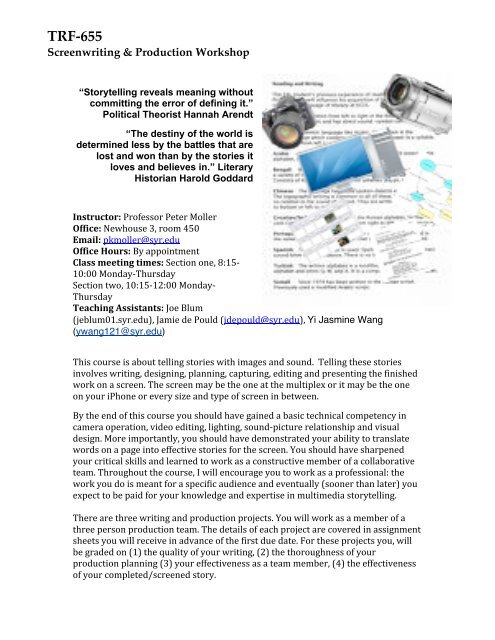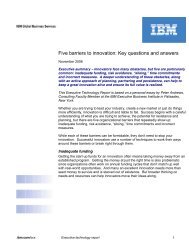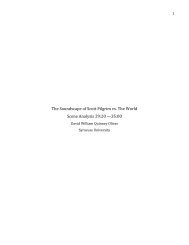TRF-655 - Syracuse University
TRF-655 - Syracuse University
TRF-655 - Syracuse University
Create successful ePaper yourself
Turn your PDF publications into a flip-book with our unique Google optimized e-Paper software.
<strong>TRF</strong>-<strong>655</strong><br />
Screenwriting & Production Workshop<br />
“Storytelling reveals meaning without<br />
committing the error of defining it.”<br />
Political Theorist Hannah Arendt<br />
“The destiny of the world is<br />
determined less by the battles that are<br />
lost and won than by the stories it<br />
loves and believes in.” Literary<br />
Historian Harold Goddard<br />
Instructor: Professor Peter Moller <br />
Office: Newhouse 3, room 450 <br />
Email: pkmoller@syr.edu <br />
Office Hours: By appointment <br />
Class meeting times: Section one, 8:15-‐<br />
10:00 Monday-‐Thursday <br />
Section two, 10:15-‐12:00 Monday-‐<br />
Thursday <br />
Teaching Assistants: Joe Blum <br />
(jeblum01.syr.edu), Jamie de Pould (jdepould@syr.edu), Yi Jasmine Wang<br />
(ywang121@syr.edu) <br />
This course is about telling stories with images and sound. Telling these stories <br />
involves writing, designing, planning, capturing, editing and presenting the finished <br />
work on a screen. The screen may be the one at the multiplex or it may be the one <br />
on your iPhone or every size and type of screen in between. <br />
By the end of this course you should have gained a basic technical competency in <br />
camera operation, video editing, lighting, sound-‐picture relationship and visual <br />
design. More importantly, you should have demonstrated your ability to translate <br />
words on a page into effective stories for the screen. You should have sharpened <br />
your critical skills and learned to work as a constructive member of a collaborative <br />
team. Throughout the course, I will encourage you to work as a professional: the <br />
work you do is meant for a specific audience and eventually (sooner than later) you <br />
expect to be paid for your knowledge and expertise in multimedia storytelling. <br />
There are three writing and production projects. You will work as a member of a <br />
three person production team. The details of each project are covered in assignment <br />
sheets you will receive in advance of the first due date. For these projects you, will <br />
be graded on (1) the quality of your writing, (2) the thoroughness of your <br />
production planning (3) your effectiveness as a team member, (4) the effectiveness <br />
of your completed/screened story.
<strong>TRF</strong>-<strong>655</strong><br />
Screenwriting & Production Workshop<br />
2 <br />
CLASS: <br />
Class time is for demonstration, discussion, <br />
proposal presentation, production <br />
meetings and the critical analysis of <br />
screenings. Some class periods will be used <br />
for story/script conferences. <br />
I expect you to attend all classes and arrive <br />
on time. You cannot be an effective <br />
member of your production team if you <br />
miss class or show up late. If you miss class <br />
or consistently come late, it will be <br />
reflected in the Participation component of <br />
your grade. <br />
READING: <br />
Some reading assignments may not be <br />
explicitly covered in class. It will be <br />
assumed you’ve done the reading. You are <br />
responsible for all reading assignments on <br />
quizzes and the final exam. <br />
• In the Blink of an Eye by Walter Murch. <br />
• Final Cut Pro Tutorial by Bruce Strong. [Available on BlackBoard] <br />
• Overview of the Production Process by Peter Moller. [Available on BlackBoard] <br />
• The Writer’s Journey…Screenwriters by Christopher Vogle. <br />
• Selected readings assigned in class. <br />
WRITTEN WORK REQUIREMENTS: <br />
• Must be handed in on the due date. Late work will be penalized 5% for each <br />
day past the due date and time. No exceptions. (If you have a dog that tends <br />
to eat your work, buy a muzzle. If you have a computer or printer that <br />
conveniently misbehaves just before an assignment is due, plan ahead and <br />
use any of the thousands of computers/printers in open labs on campus. If <br />
you are the kind of person who doesn’t bother to make note of due dates and <br />
all that boring stuff, this might not be the profession you want to pursue.) <br />
• Must have a cover page with your name and the name of the assignment. <br />
• Must be typed neatly, without copy edits, spelling errors or grammatical <br />
errors. <br />
• Each page of the assignment must be numbered in the top right hand corner. <br />
(The cover page does not count as page #1.)
<strong>TRF</strong>-<strong>655</strong><br />
Screenwriting & Production Workshop<br />
3 <br />
• The pages should be stapled <br />
together; do not use paper clips, <br />
pins, scotch tape, etc. Understand <br />
that for all sorts of reasons, I do not <br />
walk around with a stapler in my <br />
pocket. Nor are there staplers in <br />
classrooms. Plan ahead. Staple well <br />
in advance. <br />
• Use only a Times Roman or Courier <br />
font, 12 point. <br />
• I take off one point for each error in <br />
spelling and/or grammar. You <br />
should carefully edit, rewrite and <br />
proofread everything you hand in. I <br />
will not accept any work that <br />
appears to be a first draft. <br />
QUIZ AND EXAM: <br />
• July 21. Multiple-‐choice and fill-‐in-‐the-‐blank quiz on camera, editing, visual <br />
language, etc. <br />
• August 13. Final Exam. A comprehensive essay exam on the course and <br />
readings. Note: This is a Friday. Don’t make plans to leave <strong>Syracuse</strong> before <br />
this date. <br />
PARTICIPATION: <br />
• Participation in and contribution to class discussions/critiques. <br />
• On-‐time attendance to every class <br />
• Constructive participation in and contribution to group projects
<strong>TRF</strong>-<strong>655</strong><br />
Screenwriting & Production Workshop<br />
4 <br />
GRADING: <br />
Each project you complete during the <br />
semester is worth a certain number of <br />
points. When you complete the different <br />
stages of each project, you will receive <br />
points for that part of the assignment. At <br />
the end of the semester, the total number <br />
of points you accumulate will be a <br />
percentage of the total number of points <br />
for all projects and exams. That percentage <br />
will determine your grade. (90-‐100%=A; <br />
80-‐89%=B; etc.) <br />
• Project one: 60 second film based <br />
on a theme…………50 points <br />
• Project two: telling a non-‐fiction <br />
story……………….….125 points <br />
• Project three: telling a fiction <br />
story………………………..150 points <br />
• Quiz……………………………………………………………………….25 points <br />
• Final Examination………………………………….……………..100 points <br />
• Attendance and Participation……………..…………………150 points <br />
• TOTAL……………………………………………..………………..600 points
<strong>TRF</strong>-<strong>655</strong><br />
Screenwriting & Production Workshop<br />
5 <br />
USING BLACKBOARD: <br />
During the semester you will use an <br />
Internet site called "BlackBoard" to access <br />
course assignments/materials and <br />
communicate with me and other students <br />
in the class. You must use BlackBoard if <br />
you want to read assignment sheets, <br />
required texts, supplemental materials, etc. <br />
Signing on to Blackboard is simple: <br />
1. Once you are on the Web, type in the <br />
following address: blackboard.syr.edu. <br />
Press Enter. <br />
2. Click on Login. <br />
3. Type in your user id, which is your CMS <br />
<strong>Syracuse</strong> <strong>University</strong> user id. (The first part of your <strong>Syracuse</strong> <strong>University</strong> email <br />
account.) For example, for me it would be pkmoller. <br />
4. Type in your CMSI password. <br />
5. Press Enter or click on Login. <br />
6. You'll click on the link for “<strong>TRF</strong>-‐<strong>655</strong> merged”. <br />
Once you're into the <strong>TRF</strong>-‐<strong>655</strong> course main page, you'll see along the left side the <br />
buttons that will help you navigate "Blackboard." You can view announcements <br />
(that I might post in between classes), assignments, lecture material, send email to <br />
others in the class, etc. <br />
When finished, be sure to click on the Logout button to assure no one but you uses <br />
the system. <br />
Note: Do not attempt to use another account (yahoo or hotmail or doodoo) for <br />
BlackBoard. You can only use BlackBoard with your SU account. Any communication <br />
I send to you (that you might want to receive) will only come to you through your <br />
SU account. This is important because often during the semester I will need to send <br />
notifications about special events, due dates, your income tax, etc. that you’ll want to <br />
be aware of.
<strong>TRF</strong>-<strong>655</strong><br />
Screenwriting & Production Workshop<br />
6 <br />
NEWHOUSE SCHOOL POLICY ON <br />
PUBLICLY FILMED PERFORMANCES: <br />
Registration in this class implies that the <br />
student understands and accepts the <br />
following policies concerning the taping or <br />
filming of class projects on the streets of <br />
the City of <strong>Syracuse</strong>, or <strong>Syracuse</strong> <strong>University</strong> <br />
Property. <br />
1. <strong>Syracuse</strong> <strong>University</strong> has very strict <br />
policies about the possession and use of <br />
weapons. Occasionally, students will devise <br />
scripts that involve "prop" weapons. <br />
Because of repeated failures to avoid <br />
dangerous incidents with filmed weapons, <br />
the Newhouse School cannot permit the <br />
use of weapons in films made by its <br />
students for any reason under any <br />
circumstances. <br />
This is particularly necessary given how sensitive the public is now about violence <br />
and terrorism. Student filmmakers are advised to devise scripts that don't rely on <br />
violent acts that require the use of prop weapons. This should be considered a test <br />
of the writer's imagination. <br />
2. <strong>Syracuse</strong> <strong>University</strong> also has very strict policies against the possession and use of <br />
drugs and alcohol. Any scenes involving scripted alcohol or drugs must be props, <br />
NOT the real thing. If you have any questions on how to deal with such props, please <br />
ask your instructor.
<strong>TRF</strong>-<strong>655</strong><br />
Screenwriting & Production Workshop<br />
7 <br />
<strong>TRF</strong>-<strong>655</strong>, Summer 2011 <br />
Project #1, Shooting and <br />
Editing (50 points) <br />
Your objective for this project is to write, <br />
design, shoot and edit a film that is exactly <br />
one minute in length. There will be no sync <br />
sound but music and/or sound effects <br />
should be used. <br />
The assets you gather to tell your story will <br />
be edited and mixed by one of your <br />
teammates. <br />
If you complete all steps of the process on <br />
time, you will receive all the possible <br />
points. <br />
The objectives of this exercise are to: <br />
assure you can tell a simple story for the screen <br />
encourage you to think, plan and design as a filmmaker <br />
assure you can write a short proposal and create story boards <br />
assure you know how and why to slate a shot <br />
assure you understand the basic operation of the camera <br />
assure you can make an effective visual composition <br />
assure you can perform a simple edit <br />
assure you understand the basics of digital video/audio editing <br />
encourage you to experiment with the sound-‐picture relationship <br />
assure you understand how to manage digital assets <br />
<br />
Your story and film should deal with one of the following themes: <br />
Teams A, B, E, F, I: “Art Imitates Life” <br />
Teams C, D, G, H, K: “Life Imitates Art” <br />
PART A, PLANNING. Due Friday, July 9 in class. (25 points) <br />
Write a paragraph proposal that describes the story (not the plot) you want to tell. <br />
Also prepare storyboards of every shot in your film (storyboard forms are available <br />
on BlackBoard). Be sure to read standards for written work in the syllabus.
<strong>TRF</strong>-<strong>655</strong><br />
Screenwriting & Production Workshop<br />
8 <br />
PART B, SHOOTING Due Tuesday, July <br />
13 in class. (5 points) <br />
Each of you will shoot raw footage <br />
composed of the different set-‐ups required <br />
to fulfill your storyboards. You can have as <br />
many takes of each shot as needed. <br />
While you’re shooting, the others on the <br />
team will serve as the grips, actors, <br />
servants, etc. <br />
Every take of each shot should be slated <br />
with your name, date, shot and take <br />
number. <br />
The tape you use should be labeled clearly <br />
with your name and the contents of the <br />
tape. <br />
This part of the project should be <br />
completed in time to show what you <br />
consider your best shot in class on <br />
Tuesday, July 13. Be prepared to talk about the choices you made in terms of <br />
composition and angle; tell us how this shot relates to your story. <br />
NB: Bring your tape to class cued to the exact spot where you want to begin. If <br />
you don’t do this, we don’t screen your footage. It wastes valuable class time to <br />
search through your tape looking for one shot. <br />
PART C, SILENT CUT Due Thursday, July 19. (5 points): <br />
Before you begin this part of the assignment, make sure you’ve read: <br />
• Final Cut Pro Tutorial. (BlackBoard in the Documents area) <br />
• In The Blink of an Eye. <br />
•<br />
You will edit the footage shot by one of your teammates. Your edit should follow the <br />
sense and spirit of the story as suggested in the original proposal and storyboards <br />
your teammate will give you with his/her footage. <br />
PART D, COMPLETED FILM Due Thursday, July 22. (15 points): <br />
After creating the silent cut, you will add a sound track and graphics (title, credits, <br />
etc). The completed video should be exactly :60 seconds long and tell a simple story <br />
without dialogue. It should have ten seconds of black at the beginning (not part of <br />
the total run time) and five seconds of black after the last image/sound (not part of <br />
the total run time).
<strong>TRF</strong>-<strong>655</strong><br />
Screenwriting & Production Workshop<br />
9 <br />
<strong>TRF</strong>-<strong>655</strong>, Summer 2011 <br />
Project #2, <br />
Nonfiction/documentary <br />
film (125 points) <br />
“In feature films the director is God; in <br />
documentary films God is the <br />
director.”Director Alfred Hitchcock <br />
“Every cut is a lie. It’s never that way. <br />
Those two shots were never next to each <br />
other in time that way. But you’re telling a <br />
lie in order to tell the truth.” Documentary <br />
filmmaker Wolf Koenig <br />
A non-‐fiction story is rooted in reality. The <br />
basis of the story exists regardless whether <br />
someone is there to record and tell it. An <br />
important principle in quantum physics, the Heisenberg Uncertainty Principle, says <br />
that the act of observing something inevitably changes that which is observed. This <br />
is generally true in non-‐fiction storytelling. In non-‐fiction (stories that might be <br />
labeled “journalism”) storytellers work hard to minimize their personal impact on <br />
the story. In less journalistic pieces, the storytellers may even become part of the <br />
tale. But in all cases, the basis of the story itself pre-‐exists the arrival of the <br />
storytellers. Examples will be shown in class. <br />
Assume that MOLLER MAMMOTH MEDIA, inc. ltd. has put up the money for this film. <br />
I am the executive producer. The finished 3-‐5 minute film will be on the MMM web <br />
site for all the world to see. So, it is important it have an audience beyond this class. <br />
Before beginning this project, read on BlackBoard: <br />
Murch Article; Overview of the Production Process <br />
Select one of the following general themes on which to base your proposal: <br />
Diversity <br />
Living Green <br />
Limits on Freedom <br />
Lost in Time <br />
Mangled Media <br />
Technology <br />
Commerce and Culture <br />
What is New is Old
<strong>TRF</strong>-<strong>655</strong><br />
Screenwriting & Production Workshop<br />
10 <br />
There are five stages to this project: <br />
PART A, PLANNING. Due Thursday, July <br />
15 in class. (70 points) <br />
Each person will write a proposal that <br />
describes the story (not the plot) you want <br />
to tell. Include the proposed title and log <br />
line for the film. Also prepare an outline of <br />
how you think the film will be structured <br />
and what is its content. On BlackBoard, <br />
under DOCUMENTS you will find an <br />
example of such a proposal and outline. <br />
On July 15 you will pitch your film to the <br />
other members of your team. Your team <br />
will then select one of the team’s proposals <br />
to produce. <br />
PART B, CAPTURING ASSETS. <br />
Once your team has committed to one of <br />
the proposals/outlines, you will each <br />
assume one of these positions to complete the design and execution of the film. <br />
Producer: This person wrote the original proposal. She/he is responsible for <br />
creating a consistent visualization of the project. The Producer makes sure that <br />
all necessary elements of the story have been recorded or photographed. While <br />
shooting the project, this person keeps a tape log of each shot. The Producer is <br />
responsible for assembling all the required elements in the production book. <br />
Director of Photography: This person shoots the interviews and scenes as <br />
directed by the Producer. This person is also in charge of audio recording, <br />
monitoring audio as it is recorded, and keeping a log of which tracks are suitable <br />
for the final production and which are not. <br />
Editor and Designer: Once the sound and image assets have been gathered, this <br />
person will edit the first and final cuts of the story. He/she will create an edit <br />
decision list before starting to edit. Graphic design and sound production are also <br />
the responsibilities of this person. In consultation with the Producer, he/she <br />
makes decisions about the graphic look of the project (titles, credits, lower thirds <br />
if any) and what music, location sound and/or sound effects might be used. <br />
Preplanning all of these elements is essential to the success of the story. <br />
PART C, ROUGH CUT DUE Monday, July 26 (25 points): <br />
Edit the footage to tell the story outlined in your proposal and detailed in your <br />
outline. We will screen and critique your rough cut in class.
<strong>TRF</strong>-<strong>655</strong><br />
Screenwriting & Production Workshop<br />
11 <br />
PART D, COMPLETED FILM AND <br />
PRODUCTION BOOK DUE Thursday, July <br />
29. (25 points): <br />
After the critique session of your rough cut, <br />
you will have two days to respond to <br />
comments and complete the film. We will <br />
screen it in class. <br />
The Production book is handed in with the <br />
finished film. (It is worth 10 points). It <br />
should be a professional looking <br />
presentation that includes: revised <br />
proposal and outline, tape log, edit decision <br />
list and releases. <br />
PART E, CONFIDENTIAL TEAM <br />
EVALUATION DUE Thursday, July 29 (5 <br />
points): <br />
This form is available for you to download <br />
from BlackBoard, DOCUMENTS. <br />
MMM WILL EVALUATE YOUR FILM BY THE FOLLOWING CRITERIA. (BE SURE <br />
TO READ BEFORE YOU START WORK): <br />
• Is the finished film true to the concepts of the proposal? <br />
• Is the finished film of a high enough quality to inform and entertain a <br />
larger audience than this class? <br />
• Do the shot compositions support and complement the story? <br />
• Does the sound design support and complement the story? <br />
• Does the editing create a sense of pace/rhythm that helps tell the <br />
story? <br />
• Do the graphics (titles, credits, etc.) complement and support the <br />
story? <br />
•<br />
Did the production team control all aspects of the visual language in the <br />
frame to complement and support the story?<br />
• Did the production team work collaboratively and professionally? <br />
• Did the production team take responsibility for their technical and <br />
artistic choices?
<strong>TRF</strong>-<strong>655</strong><br />
Screenwriting & Production Workshop<br />
12 <br />
<strong>TRF</strong>-<strong>655</strong>, Summer 2011,<br />
Project #3<br />
Fiction narrative, 150 points<br />
“The difference between fiction and<br />
reality? Fiction has to make sense.”<br />
Novelist Tom Clancy<br />
“Fiction reveals truth that reality<br />
obscures.”<br />
Poet Ralph Waldo Emerson<br />
Stories that are fictions are scripted and<br />
designed realities. They represent the<br />
constructed reality of their writers and<br />
directors. The process of turning ideas in<br />
the script into sound-picture representations on the screen is dictated more by<br />
economics than the natural course of the story itself. Fiction stories take full<br />
advantage of the plasticity of the visual language; they guiltlessly expand and<br />
contract time and space, exploit multiple points of view (POV) and move<br />
effortlessly through past, present and future moments of characters’ lives. The<br />
Great Ape King Kong may never have walked the earth, but don’t tell that to the<br />
people screaming in terror watching the movie.<br />
For this project, each team will write, design and produce a short (three to five<br />
minutes) fiction film that would be suitable for broadcast or the Internet. The goal<br />
of the finished video is to tell a compelling story. It will be important to create<br />
believable characters, each with an arc that shows clearly how they have<br />
changed as a result of the experience(s) they have in the story.<br />
For this assignment read the following pieces under READING ASSIGNMENTS<br />
on BLACKBOARD:<br />
“Mise en Scene”<br />
“Precursor to the Cinema” (You may want to use this short story as an<br />
inspiration for your script.)<br />
STEP A. SYNOPSIS AND FIRST DRAFT OF SCRIPT. DUE MONDAY<br />
AUGUST 2 IN CLASS. 25 POINTS:
<strong>TRF</strong>-<strong>655</strong><br />
Screenwriting & Production Workshop<br />
13 <br />
Everyone in the class will submit and<br />
pitch an idea for this film in the following<br />
form:<br />
— a paragraph synopsis that summarizes<br />
your story<br />
— a first draft master scene of your script<br />
using the proper film script format (see<br />
template for this on BlackBoard).<br />
Teams will be formed around four or five<br />
of these scripts that survive the pitch.<br />
STEP B. FINAL SCRIPT AND DESIGN<br />
DOCUMENTS. DUE WEDNESDAY,<br />
AUGUST 4 IN CLASS. 15 POINTS:<br />
After the team has chosen one of the<br />
draft scripts to produce, each member of<br />
the team will write one of the following<br />
documents:<br />
1. Writer: A final draft of the master scene script. This person will serve as<br />
Videographer in the Production phase.<br />
2. Director: A shot by shot director’s script based on the writer’s master<br />
scene script. (see BlackBoard for template of a director’s script).<br />
3. Designer: a description and if necessary sketches of sound, light,<br />
costume and set design. This person will become the Editor in the<br />
Production phase.<br />
4. Production Manager: a production script that details the schedule for<br />
shooting each shot and the production elements required for each shot<br />
(sets, lights, microphones, camera(s), costumes, props, settings/locations,<br />
special effects, etc.) This person will become the Producer in the<br />
Production phase and will assemble the final production book.<br />
STEP C. COMPLETED VIDEO. DUE THURSDAY, AUGUST 12 IN CLASS. 90<br />
POINTS:<br />
Rough cut: Tuesday, August 10<br />
PRODUCTION BOOK. DUE August 12 IN CLASS. 10 POINTS:
<strong>TRF</strong>-<strong>655</strong><br />
Screenwriting & Production Workshop<br />
14 <br />
The person designated as the Producer is<br />
responsible for assembling the production<br />
book that will contain: production<br />
schedule, tape log, edit decision list,<br />
scripts (director’s and writer’s), story<br />
boards, design documents/sketches,<br />
technical story boards, releases.<br />
Each member of the team will hand in<br />
a completed production team<br />
evaluation (worth 10 points) on August<br />
13.<br />
NOTE: Be sure all written work for this<br />
assignment conforms to the requirements<br />
specified in the course syllabus.








